|
Jeff Herke
2012
Metal Detecting Finds From England
3rd Century Roman Bronze Coin
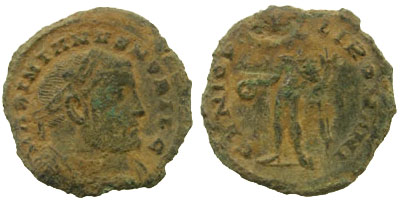
This is a relatively early follis. As you probably know, the social
and economic chaos of the 3rd century was finally brought under
control by Diocletian and the tetrarchic system of 2 Augusti and 2
Caesars. This monetary reform created a large (quite nearly the size
and weight of a 2nd century sestertius) silvered billon piece the
exact name of which we don't know, but is generally called a "Follis".
Of course, the stability of neither the political nor the economic
reform lasted all that long. When the 2nd Tetrarchy inevitably broke
up, it brought about the decades of strife, first with Maxentius and
then the Licinii, that Constantine I endured, finally becoming the
unchallenged sole ruler of the empire in 324.
The most common of the many reverses the follis had over the years
while it was declining in size (and buying power, as well,
presumably) from the large, silvered "Æ 1" to its final issues c.
320, by which time it had shrunk to approximately the size and
weight of a New Penny, was GENIO POPVLI ROMANI - or the Genius of
the Roman People with the personification of Genius standing left,
generally holding or pouring a libation from a patera.
That's what we have here - the reverse, at any rate, is easily ID'd
as a Genio Populi Romani type. The obverse and the question of who's
on it gave me a bit more trouble. The seemingly clear letters didn't
easily fall into line with any of the names I generally associate
with the early, large GPR folles - the members of the 1st tetrarchy
and the 8 or 10 successors who variously were part of the 2nd
tetrarchy, etc.- at first. Then, when I realized what looks like an
"X" at about 11:00 was in fact an "A" with an uncharacteristically
widely separated top ("A's" generally didn't meet at the top in this
era, but this is really unusually widely spaced) it became more
obvious that MAXIMIANVS was the name involved. Then we have the
issue of what is following the name - generally, and most usually,
it would be P F AVG - but it's obviously not. In fact, the first
letter after the final "S" in Maximianus is clearly an "N" - and
that's uncharacteristically clear for this piece, so it must be a
NOB CAES type ending - the title of a Caesar. Maximian, Diocletian's
colleague Augustus in the 1st tetrarchy was never a Caesar, however.
So, we must have a coin of the only other person who ever used the
name MAXIMIANVS - a Caesar in the 1st, then Augustus in the 2nd
tetrarchy, who is more commonly called "Galerius". He was Caesar
from 293 to 305 when he was elevated to Augustus on the abdication
of Diocletian and his namesake Maximian.
Looking more closely at the end of the obverse legend, we see it
really can't be NOB CAES, however. It turns out to be an unusual
NOBIL C and this plus the fact that there is no exergual mint mark
on the reverse, instead of making it impossible to tell the mint,
actually clearly tells us which mint produced it - the mint that
didn't use an exergual mint mark for a while, but did use the
unusual NOBIL C title - London.
So this piece is a product of the mint of London, a mint which has
not been well represented among the pieces you've sent me for ID's.
You have an unusual "homeland" variety of the follis type, "GPR",
which is so common across the rest of the Empire with exergual mint
marks and/or field marks. The reference is RIC VI London # 33 and it
dates to 303-305 AD.
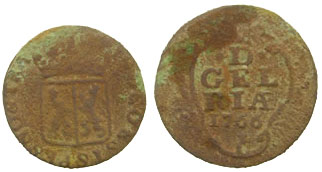
1766 Dutch Provinces Coin |
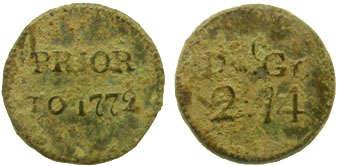
1772 dated coin weight - these are pennyweights,
abbreviated Dwt and grains.
2 pennyweight and 18 grains coin weight. |
| |
|
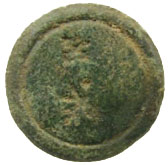
1464 Gold Ryal Coin Weight |

Medieval book clasp. |
| |
|
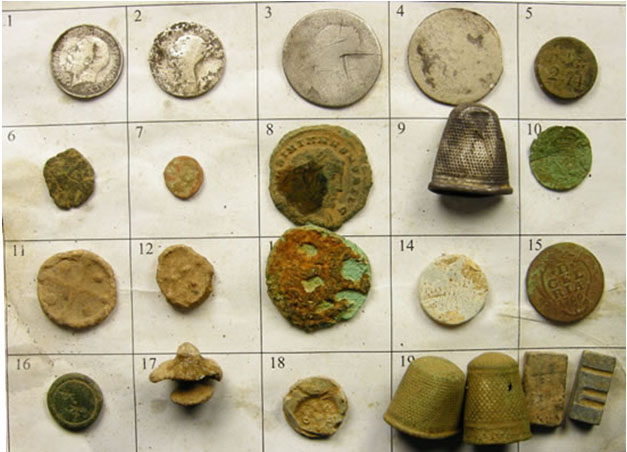 |
1.1922 George V milled silver sixpence
2.1839 Victoria milled silver 6 pence
3. 17th C William III milled silver shilling -
worn
4.17th C William III milled silver shilling -
worn
5.1772 dated coin weight - these are penny
weights, abbreviated Dwt and grains 2 penny weight and
18 grains coin weight
6.4thC Roman bronze coin - illegible
7.4thC Roman bronze coin - illegible
8. 303-305AD Augustus Roman bronze Genio Populi
Romani type London mint
9.Georgian silver thimble
10. 1603 James1st hammered copper farthing
11.15thC lead token - type 2
12.Post medieval lead bale seal
13. 2ndC Roman bronze coin - illegible
14.Post medieval lead bale seal
15.1766 Dutch provinces coin
16.1464 gold Ryal coin weight
17. Georgian lead tobacco jar lid handle
18. Post medieval lead bale seal
19. 2 Georgian thimbles
20. Printing press space blocks |
| |
|
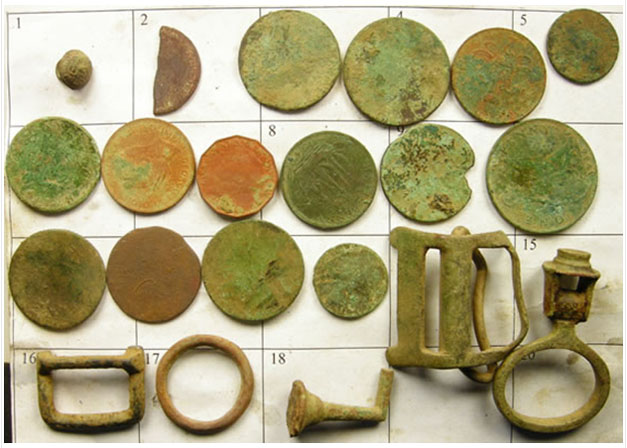 |
1. 16thCTudor buttons
2. 15 18thto 20thC copper coins
14. 19th C buckle
15. Georgian draw handle
16. 20th C harness buckle
17. Post medieval harness ring
18. Georgian hook
|
| |
|
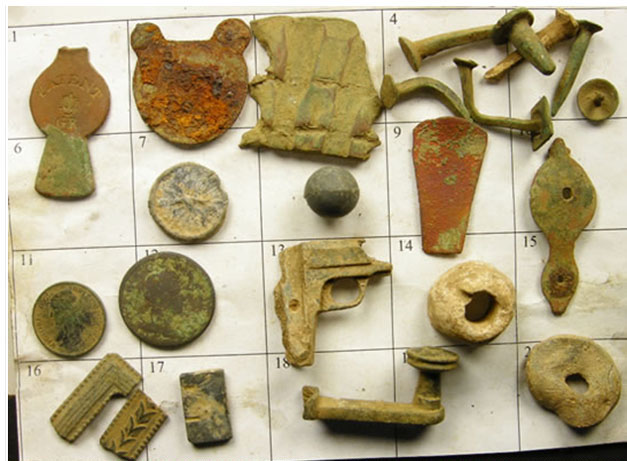 |
1. Georgian keyhole cover Crown GR
2. Georgian padlock
3. WWII AA flack shell fragment
4. 7nails/tacks
7. 15thC lead token
8. Lead musket ball
9. Spoon handle
10. Georgian mount
11.2 18th to 20th C copper coins
13. Toy gun fragment
14. Post medieval lead hanging wright
16. 2 Georgian buckle fragments
17. Printing press space block
18. Georgian window catch
20. Lead washer
|
| |
|
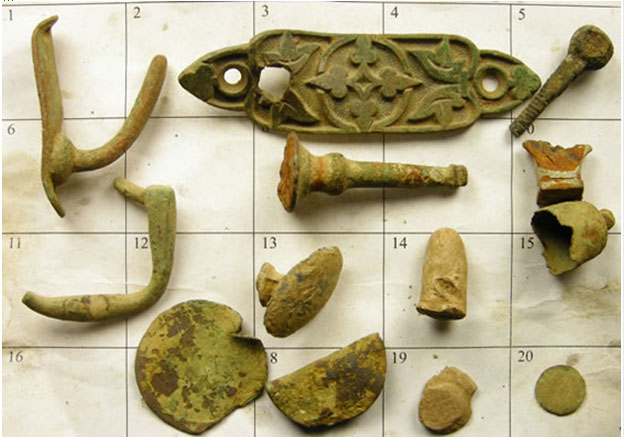 |
1. Victorian hook
2. Victorian mount
3. Georgian draw pull support
8.Georgian hook
10. Roman bronze pot foot
11. 20thc harness buckle
13.Georgian lead tobacco jar lid handle
14. Lead bullet
15. Georgian horse bell fragment
17. 2 copper discs
19. Post medieval lead cloth seal
20.4thC Roman bronze coin - illegible |
| |
|
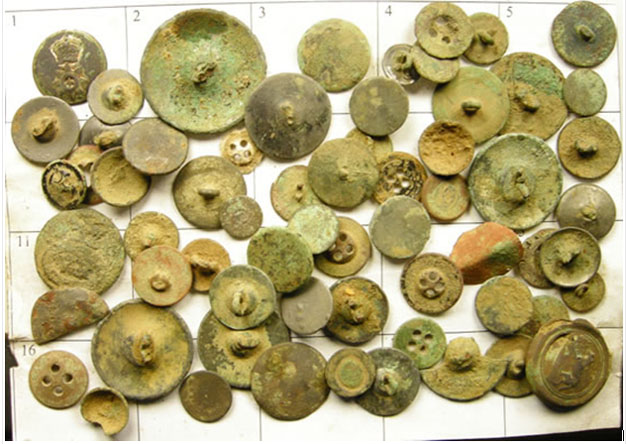 |
63 Post Tudor Buttons. |
| |
|
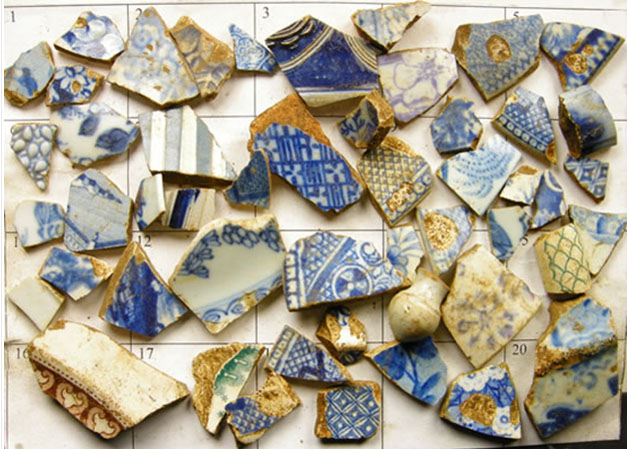 |
50 Post Tudor Pottery Shards. |
| |
|
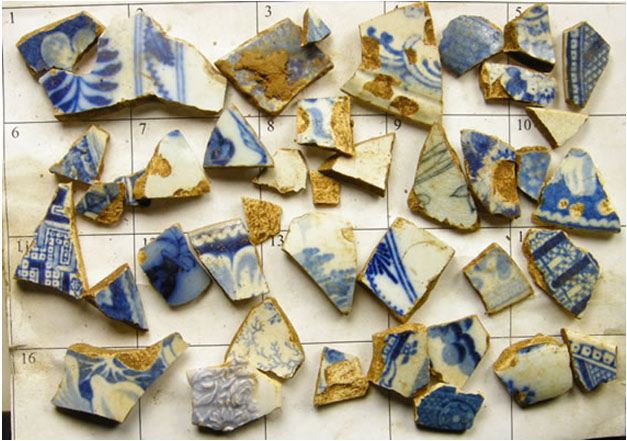 |
41 Post Tudor Pottery Shards. |
| |
|
[top] |
